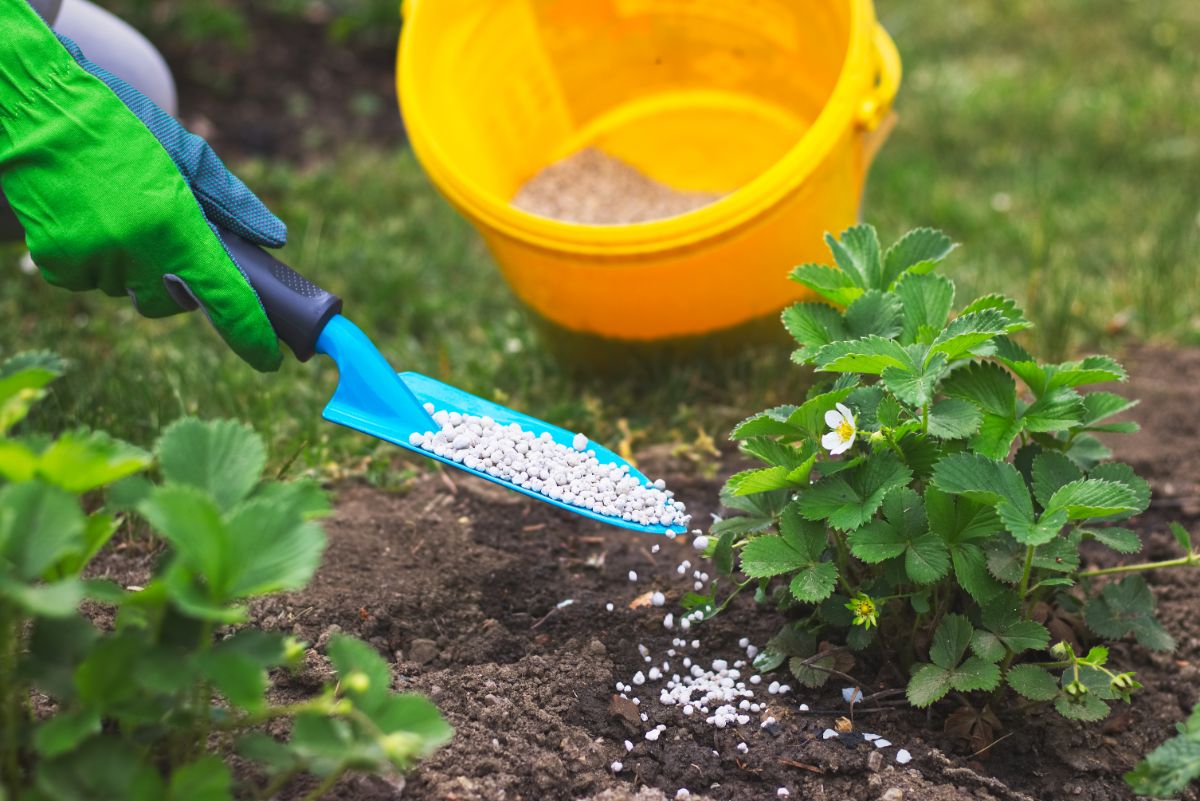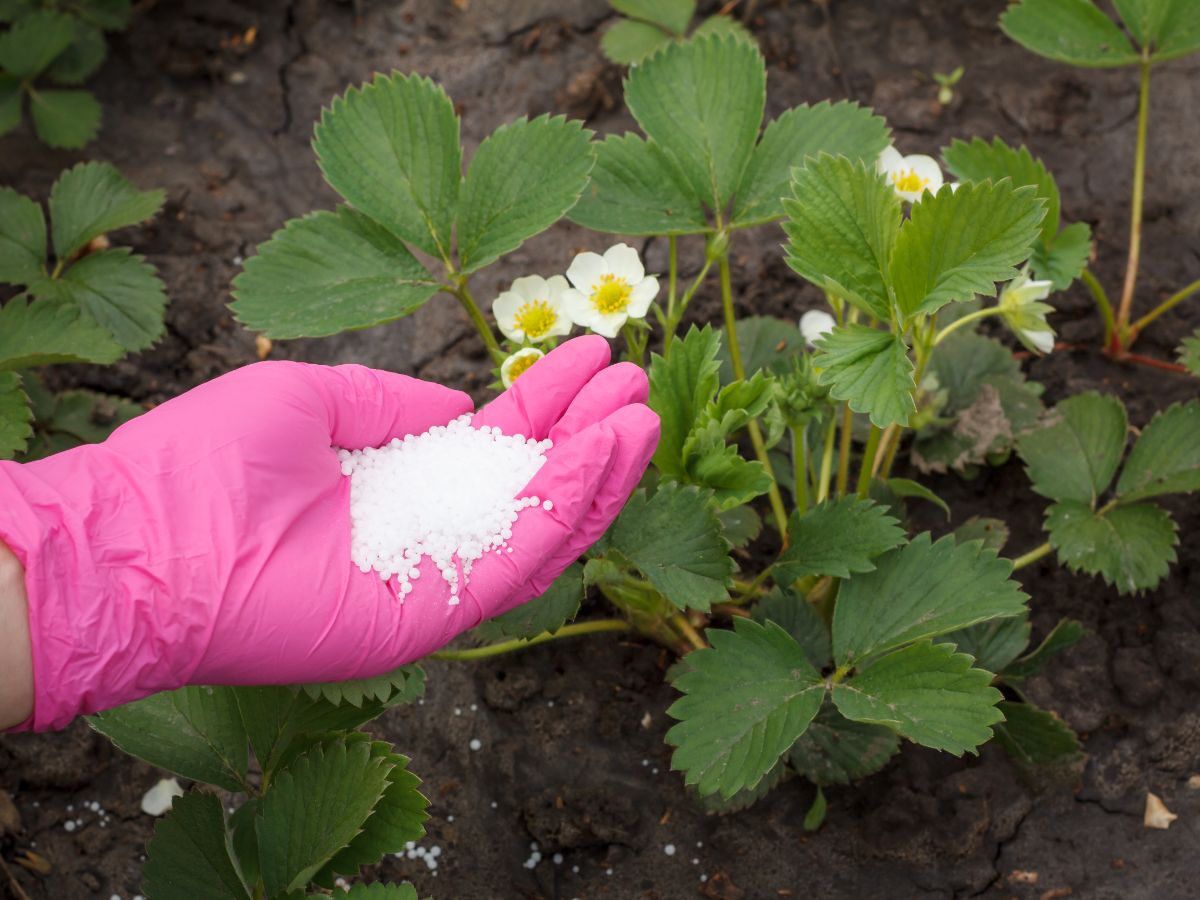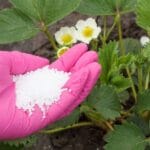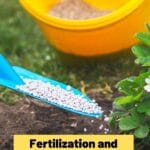If you want to grow a bountiful crop of big, beautiful, tasty strawberries you absolutely must fertilize your strawberry plants. In this article we will discuss the kinds of nutrients strawberries need and how you can provide them for your strawberry plants in containers, in garden beds, in your greenhouse hydroponic system, and in larger commercial-scale strawberry plant production.
Jump to:
Strawberry Plant Roots Absorb Nutrients From Their Growing Medium.
The roots of strawberry plants absorb nutrients from a growing medium. In your backyard strawberry patch or if you are growing a field of strawberries, the growing medium is the soil. Home gardeners need to amend their soil with lots of compost before planting because they usually leave the plants in the strawberry bed for several years, but commercial growers replace plants every year so they can amend the soil every year.

Why is compost or “organic matter” important for strawberry plants growing in the soil? Organic matter releases water and nutrients slowly and dependably for your plants. And organic matter feeds the fungi that send out long thread-like mycelia into the soil to bring your plants the nutrients they can’t reach with their own roots. (It’s important not to compress the soil around your strawberry plants, as this kills the fungi that help them reach nutrients.)
In a greenhouse, you might water and fertilize your strawberry plants with a drip irrigation system so your strawberry plants will do fine in a growing medium of coconut fiber called coir or another artificial soil substitute.
When you grow your strawberries in containers or in a gutter system, you give your plants small amounts of the nutrients they need frequently rather than large amounts of fertilizer and organic matter at the beginning of the growing season. When you grow your strawberry plants in a greenhouse, you can fine-tune fertilizing to provide the right nutrients in the right amounts for each stage of strawberry production.
Strawberry plants can also absorb nutrients through their leaves. The practice of fertilizing strawberry plants through their leaves with liquid fertilizers is called foliar feeding. It’s important for the liquid fertilizers used in foliar feeding not to be too strong. We’ll discuss foliar feeding in more detail later in this article.
Which Nutrients Do Strawberry Plants Need?
[amazon bestseller=”Strawberry fertilizer” items=”4″ template=”table”]
Strawberry plants need all of their nutrients all of the time, but they need greater amounts of particular nutrients at some points of their life cycle than at others.
When you are buying commercial chemical fertilizers you will usually see three numbers on the side of the bag. These numbers tell you the amount of the strawberry plant macronutrients in the fertilizer.

Nitrogen is the first-named component of chemical fertilizers and it’s supplied in abundance in manure teas and fish emulsion. It is important to grow runners and leaves but not as important when your strawberry plants set fruit.
Phosphorus is the second-named component in chemical fertilizers. Strawberry plants need phosphorus to make the compounds that enable them to do photosynthesis. Strong sunlight and grow lamps won’t be beneficial to your strawberry plants if you don’t provide them with enough phosphorus.
Potassium is the third-named component in chemical fertilizers. It’s the element strawberry plants use to regulate their use of water. It helps your strawberry plants get through dry periods and also helps them fight disease.
These three macronutrients may be all you get in a commercial fertilizer, but there are micronutrients that are important, too.
- Boron is essential for reproduction. Strawberry plants use it to make the hormones that power the elongation of the pollen tube to form the tiny seeds you see on the surface of the strawberry.
- Boron, calcium, and zinc are all essential for pollen production. No pollen, no strawberries. Strawberry plants that don’t get enough of these three micronutrients don’t make all the pollen they need for a heavy fruit set. When a strawberry is only producing a few seeds (just to review, the seeds are those tiny specks you see on the surface of the strawberry), there is no need to produce a big strawberry. Without enough of these three elements, strawberries do not grow even to normal size much less to a big berry” size.
- Boron and molybdenum assist the strawberry in forming sugars and acids. These micronutrients are necessary for a strawberry to have both sweet and tart tastes.
- Calcium empowers strawberries to resist fungus and mold.
- Copper helps strawberry leaves and runners use the sugars the sugars they make during photosynthesis for the plant’s energy needs
- Iron is important for producing chlorophyll. Strawberries that grow on iron-deficient soils, or that can’t absorb iron from the soil because the soil is too alkaline, grow yellow leaves.
- Magnesium is also essential to producing chlorophyll. The chlorophyll molecule is organized around a magnesium atom.
- Silica helps with uptake of the big-three nutrients (nitrogen, potassium, and phosphorus) and most of the micronutrients (boron, calcium, magnesium, molybdenum, silica, and zinc).
- Sulfur is essential for the plant’s production of DNA. It’s also used for the production of ethylene, which helps strawberries ripen.
How Can You Make Sure Your Strawberry Plants Get All the Nutrients They Need?
Fertilizing strawberry plants doesn’t have to be complicated. You just need to use different approaches for different planting methods.
If you are a home gardener with a small strawberry patch, most of the nutrients your strawberry plants will use need to be put into the soil before you plant them. It is always a good idea to incorporate about 3 inches (7 or 8 cm) of well-aged compost into the top 6 inches of the soil in your strawberry bed. This compost will both provide nitrogen, phosphorus, and potassium to your strawberry plants and provide a growing medium for the fungi that bring other nutrients and water to strawberry plant roots. You can provide your strawberry plants with foliar feedings of higher-nitrogen fertilizers (always diluted according to label directions) before they blossom and seaweed sprays for micronutrients as they begin to set fruit.
If you have a larger strawberry patch, and you only keep your plants through one harvest (which means you start with strawberry plants in pots and you don’t use bare root strawberry plants), you can consider chemical fertilizers. The most important consideration for home growers is not to over-fertilize. Strawberry plants need about 75 pounds of nitrogen per acre. That is about a pound and a half of nitrogen for a 1000 square footbed, but chemical fertilizer is not 100% nitrogen. It’s more likely to be 15% nitrogen. (The label will read 15 and then some other numbers, the first number telling you the percent nitrogen.) You need about 1-1/2 pounds divided by 15% or 10 pounds of fertilizer for every 1000 square feet of the strawberry patch. Apply nitrogen fertilizer early in the growing season by scattering pellets evenly across your strawberry patch and be sure to water in.
It’s great to give your non-organic strawberry plants organic foliar feedings for nitrogen boosts as the growing season goes on and trace nutrients for berry production. Treat them the same way as you do strawberry plants in your backyard garden.
We have a whole article on how to fertilize strawberry plants in the greenhouse or hydroponic production. Consult our article on Changes in Hydroponic Water Additives That Enhance Fruiting and Flavor of Strawberries for the details of how to get superior flavor and size in your greenhouse strawberries with precision nutrients.










Butch says
I’m an a Certified Organic Grower and am growing Day neutral strawberries have lots of compost and high P levels in soil. do they need the extra N during the season?
Mary Ward says
University of Connecticut does recommend three applications of balanced 10-10-10 fertilizer for day neutral berries if you don’t have a soil test. If you did get a soil test, your should be able to either adjust accordingly or get recommendations based on that test.
https://soiltesting.cahnr.uconn.edu/suggested-fertilizer-practices-for-strawberries/
Ron Stauffer says
Dear Mr Strawberry: I use a commercial fertilizer of 10-52-17 on my plants. I would like to save some $$ and mix it myself. Can you tell me what to mix together to come up with this analysis? I read once this could be achieved with only 2 ingredients but can’t find the article. Thanks!
Mary Ward says
This might help: https://strawberryplants.org/fertilization-nutrients/